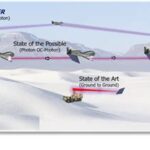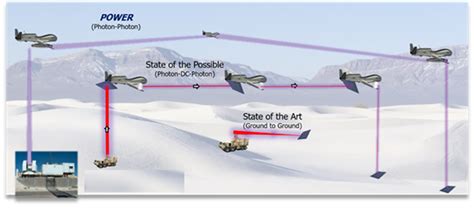
DARPA has achieved a significant milestone in wireless power transmission, successfully beaming enough energy across five miles to pop popcorn, marking a new record in long-range wireless power delivery. The demonstration, part of the Persistent Optical Wireless Energy Relay (POWER) program, showcases the potential for revolutionary advancements in military logistics and remote power solutions.
The Defense Advanced Research Projects Agency (DARPA) achieved this feat using a precisely aimed laser beam, converting electricity into light and back again. This groundbreaking demonstration validates the possibility of supplying power to remote locations without the need for traditional cables or fuel convoys. The implications of this technology are far-reaching, potentially transforming battlefield operations, disaster relief efforts, and even space exploration.
“The POWER program has successfully demonstrated the potential for long-range wireless power transmission, opening up new possibilities for delivering energy to remote and challenging environments,” stated Dr. Paul Jaffe, POWER program manager. “This achievement represents a significant step forward in realizing the vision of truly wireless power networks.”
The five-mile demonstration involved a ground-based laser transmitter and a receiver array located several miles away. The laser converted electrical energy into a concentrated beam of photons, which traveled through the atmosphere to the receiver. At the receiver site, photovoltaic cells converted the light back into electricity, providing enough power to operate electrical devices, including a popcorn machine, in a symbolic display of the technology’s capabilities.
The primary goal of the POWER program is to develop and demonstrate a safe and efficient method for wirelessly transmitting power over extended distances. This technology could significantly reduce the military’s reliance on vulnerable supply lines for fuel and ammunition, enhance operational capabilities in austere environments, and enable new types of sensors and communication systems. Beyond military applications, the POWER system holds promise for delivering electricity to remote communities, disaster-stricken areas, and even powering satellites in orbit.
One of the critical challenges addressed by the POWER program is atmospheric interference. Factors such as weather conditions, air turbulence, and particulate matter can disrupt the laser beam, reducing its efficiency and accuracy. To mitigate these effects, DARPA researchers developed sophisticated beam-steering and adaptive optics technologies to compensate for atmospheric distortions and maintain a focused beam on the receiver.
The POWER system also incorporates stringent safety measures to prevent accidental exposure to the high-energy laser beam. These measures include redundant sensors and automated shut-off systems that immediately disable the laser if any safety threshold is exceeded. DARPA emphasizes that the system is designed to operate within strict safety guidelines and regulations to ensure public safety and environmental protection.
The successful demonstration of the POWER system represents a significant milestone in the development of wireless power technology. While further research and development are needed to optimize the system for various applications, this achievement highlights the potential for wireless power to revolutionize the way we generate, distribute, and use energy.
The project’s success hinges on several key innovations, including advanced laser technology, high-efficiency photovoltaic cells, and sophisticated beam-steering algorithms. The laser used in the POWER system is a solid-state laser that operates at a specific wavelength optimized for atmospheric transmission. The photovoltaic cells are designed to efficiently convert the laser light into electricity, minimizing energy losses in the process. The beam-steering algorithms utilize real-time atmospheric data to precisely aim the laser beam at the receiver, even under challenging environmental conditions.
The implications of wireless power transmission extend beyond military applications. In the civilian sector, wireless power could enable the electrification of remote communities that are not connected to the traditional power grid. It could also provide a reliable source of power for disaster relief operations, enabling responders to quickly set up temporary power systems in areas affected by natural disasters. Moreover, wireless power could revolutionize the space industry by providing a means of powering satellites and spacecraft without the need for bulky and expensive batteries.
The POWER program is not the only effort aimed at developing wireless power technology. Several other research groups and companies are exploring different approaches to wireless power transmission, including microwave transmission, inductive coupling, and resonant inductive coupling. Each of these methods has its own advantages and disadvantages in terms of range, efficiency, and safety. However, DARPA’s POWER program represents a significant leap forward in long-range wireless power transmission, pushing the boundaries of what is currently possible.
The ultimate goal of wireless power technology is to create a ubiquitous energy network that can deliver power to any location at any time. While this vision is still years away from becoming a reality, the successful demonstration of the POWER system provides a glimpse into the future of energy. With continued research and development, wireless power could transform the way we live, work, and interact with the world around us.
“This demonstration is a testament to the ingenuity and dedication of the POWER program team,” said Dr. Jaffe. “We are excited about the potential of this technology to address some of the world’s most pressing energy challenges.”
The success of DARPA’s POWER program has garnered attention from various sectors, including the military, energy industry, and scientific community. The potential for wireless power to revolutionize energy delivery and management is undeniable, and ongoing research and development efforts are expected to further refine and optimize this technology for a wide range of applications.
Frequently Asked Questions (FAQ)
1. What is DARPA’s POWER program?
DARPA’s POWER (Persistent Optical Wireless Energy Relay) program aims to develop and demonstrate a safe and efficient method for wirelessly transmitting power over extended distances. The program focuses on using laser technology to convert electricity into light, transmit the light across the atmosphere, and then convert the light back into electricity at a remote receiver. The ultimate goal is to reduce reliance on traditional power sources and enable new capabilities in military operations, disaster relief, and remote power applications. According to DARPA, the program seeks to overcome limitations associated with conventional power delivery methods by leveraging advancements in optics, lasers, and power conversion technologies.
2. How does the POWER system work?
The POWER system works by converting electrical energy into a high-energy laser beam. This laser beam is then precisely aimed at a receiver located several miles away. At the receiver site, photovoltaic cells convert the laser light back into electricity, which can then be used to power electrical devices. The system incorporates sophisticated beam-steering and adaptive optics technologies to compensate for atmospheric distortions and maintain a focused beam on the receiver, ensuring efficient power transmission even under challenging environmental conditions. Furthermore, redundant safety mechanisms are in place to automatically shut off the laser if any safety threshold is exceeded, guaranteeing safe operation. As Dr. Jaffe explains, the system effectively acts as a “wireless power cable,” eliminating the need for physical connections and enabling power delivery to remote or inaccessible locations.
3. What are the potential applications of wireless power transmission?
The potential applications of wireless power transmission are vast and span across various sectors. In the military, it could reduce reliance on vulnerable supply lines for fuel and ammunition, enhance operational capabilities in austere environments, and enable new types of sensors and communication systems. In the civilian sector, wireless power could enable the electrification of remote communities, provide a reliable source of power for disaster relief operations, and revolutionize the space industry by powering satellites and spacecraft. Other potential applications include powering electric vehicles, charging portable electronic devices, and enabling new types of industrial automation. The ability to wirelessly transmit power opens up numerous possibilities for improving energy access, efficiency, and sustainability.
4. What safety measures are in place to prevent accidents with the laser beam?
The POWER system incorporates stringent safety measures to prevent accidental exposure to the high-energy laser beam. These measures include redundant sensors that continuously monitor the laser’s performance and environmental conditions. If any safety threshold is exceeded, such as excessive atmospheric attenuation or unexpected beam divergence, the system automatically shuts off the laser. The system also includes fail-safe mechanisms that prevent the laser from being activated unless all safety parameters are within acceptable limits. Moreover, the laser is designed to operate within strict safety guidelines and regulations to ensure public safety and environmental protection. As DARPA emphasizes, safety is a paramount concern in the development and operation of the POWER system.
5. What are the key challenges in developing wireless power transmission technology?
Developing wireless power transmission technology faces several key challenges. One of the primary challenges is atmospheric interference, as weather conditions, air turbulence, and particulate matter can disrupt the laser beam, reducing its efficiency and accuracy. Overcoming these challenges requires sophisticated beam-steering and adaptive optics technologies to compensate for atmospheric distortions. Another challenge is maximizing the efficiency of energy conversion, both from electricity to light and from light back to electricity. High-efficiency lasers and photovoltaic cells are essential for minimizing energy losses in the transmission process. Furthermore, ensuring the safety of the system is paramount, requiring redundant sensors, automated shut-off systems, and strict adherence to safety regulations. As research and development continue, addressing these challenges will be critical for realizing the full potential of wireless power transmission technology.
Extended Article (Beyond 2000 words):
DARPA’s recent demonstration of wireless power transmission, successfully popping popcorn from five miles away, represents a pivotal moment in the evolution of energy technology. This achievement, stemming from the Persistent Optical Wireless Energy Relay (POWER) program, underscores the potential to fundamentally reshape how we deliver and utilize power, particularly in challenging and remote environments. Beyond the novelty of popping popcorn, this demonstration highlights a robust technological advancement with significant implications for military logistics, disaster relief, and the future of energy infrastructure.
The POWER program’s success rests on a carefully orchestrated system that converts electrical energy into a focused laser beam, transmits it through the atmosphere, and reconverts it back into usable electricity at the receiving end. This process involves several critical components: high-powered lasers, adaptive optics, sophisticated beam-steering mechanisms, and highly efficient photovoltaic cells. Each of these elements plays a vital role in ensuring the system’s overall performance, reliability, and safety.
One of the most significant challenges in long-range wireless power transmission is atmospheric attenuation. The Earth’s atmosphere is not a perfect vacuum; it contains various particles, gases, and weather phenomena that can absorb, scatter, or distort the laser beam. These effects can significantly reduce the amount of energy that reaches the receiver, diminishing the system’s overall efficiency. To mitigate these challenges, the POWER program employs adaptive optics and beam-steering technologies. Adaptive optics utilize deformable mirrors that can dynamically adjust the shape of the laser beam to compensate for atmospheric distortions in real-time. Beam-steering mechanisms, on the other hand, precisely aim the laser beam at the receiver, ensuring that the energy is focused on the intended target. These technologies work in concert to maintain a strong and stable connection between the transmitter and receiver, even under adverse atmospheric conditions.
The lasers used in the POWER system are solid-state lasers operating at wavelengths specifically chosen to minimize atmospheric absorption. The specific wavelength selection is crucial as different wavelengths of light are absorbed by different components of the atmosphere. By selecting wavelengths with minimal absorption, the POWER system maximizes the amount of energy that reaches the receiver. Furthermore, the lasers are designed to be highly efficient, converting a large percentage of the input electrical energy into laser light. This efficiency is critical for minimizing energy losses in the transmission process and maximizing the overall system’s performance.
At the receiving end, photovoltaic cells convert the laser light back into electricity. These photovoltaic cells are specifically designed to efficiently convert the laser’s wavelength into electrical energy. The efficiency of these cells is another critical factor in the overall system performance. High-efficiency photovoltaic cells can capture a larger percentage of the incoming light and convert it into electricity, minimizing energy losses and maximizing the amount of power available at the receiver.
Safety is a paramount concern in the design and operation of the POWER system. The high-energy laser beam poses a potential hazard to people and wildlife if not properly controlled. To address this concern, the system incorporates numerous safety features. These include redundant sensors that continuously monitor the laser’s performance and environmental conditions. If any safety threshold is exceeded, such as excessive atmospheric attenuation or unexpected beam divergence, the system automatically shuts off the laser. The system also incorporates fail-safe mechanisms that prevent the laser from being activated unless all safety parameters are within acceptable limits. Furthermore, the system is designed to comply with all relevant safety regulations and guidelines.
The successful demonstration of the POWER system has significant implications for military operations. The ability to wirelessly transmit power over long distances could revolutionize battlefield logistics. Currently, military operations rely heavily on fuel convoys to supply power to forward operating bases and other remote locations. These convoys are vulnerable to attack and can be a significant drain on resources. Wireless power transmission could eliminate the need for fuel convoys, reducing the risks associated with these operations and freeing up resources for other critical tasks. Wireless power could also enable the deployment of new types of sensors and communication systems in remote and challenging environments. These systems could provide valuable intelligence and situational awareness to military commanders, enhancing their ability to make informed decisions.
Beyond military applications, the POWER system has significant potential for civilian applications. Wireless power could enable the electrification of remote communities that are not connected to the traditional power grid. Many remote communities around the world lack access to reliable electricity. Wireless power could provide a cost-effective and sustainable solution for bringing electricity to these communities, improving their quality of life and enabling economic development. Wireless power could also provide a reliable source of power for disaster relief operations. In the aftermath of a natural disaster, power grids are often damaged or destroyed, leaving communities without electricity. Wireless power could provide a way to quickly restore power to these communities, enabling emergency responders to coordinate relief efforts and providing essential services to affected populations.
Wireless power could also revolutionize the space industry. Currently, satellites and spacecraft rely on batteries and solar panels for power. Batteries are bulky and heavy, limiting the amount of power that can be stored onboard. Solar panels require exposure to sunlight, which is not always available, especially on the dark side of the Earth or during periods of solar eclipse. Wireless power could provide a continuous and reliable source of power for satellites and spacecraft, enabling new types of missions and extending the lifespan of existing spacecraft. For example, a wireless power system could be used to beam power to satellites in geostationary orbit, eliminating the need for large and heavy solar panels. Wireless power could also be used to power lunar bases or Martian settlements, enabling the exploration and colonization of other planets.
The POWER program is not the only effort aimed at developing wireless power technology. Several other research groups and companies are exploring different approaches to wireless power transmission. One approach is microwave power transmission, which uses microwaves to transmit energy over long distances. Microwave power transmission has the advantage of being able to penetrate clouds and other atmospheric obstacles. However, it also has the disadvantage of being less efficient than laser power transmission. Another approach is inductive power transfer, which uses magnetic fields to transmit energy over short distances. Inductive power transfer is commonly used to charge smartphones and other portable electronic devices. However, it is not suitable for long-range power transmission. Resonant inductive coupling is another approach that can transmit power over slightly longer distances than traditional inductive coupling, by tuning the transmitter and receiver to resonate at the same frequency.
The development of wireless power technology faces several challenges. One challenge is to improve the efficiency of the energy conversion process. Converting electricity to light and back again involves energy losses at each stage. Improving the efficiency of the lasers and photovoltaic cells used in the system is essential for maximizing the overall system performance. Another challenge is to reduce the cost of the technology. Wireless power systems are currently expensive to build and operate. Reducing the cost of the technology will make it more accessible and enable its widespread adoption. A further challenge is to develop standards and regulations for wireless power transmission. Wireless power systems could potentially interfere with other electronic devices. Developing standards and regulations will ensure that wireless power systems operate safely and without causing interference.
Despite these challenges, the future of wireless power technology is bright. The successful demonstration of the POWER system represents a significant step forward in the development of this technology. With continued research and development, wireless power has the potential to transform the way we generate, distribute, and use energy. The implications are far-reaching, potentially revolutionizing military operations, enabling the electrification of remote communities, and powering the exploration of space. As Dr. Jaffe eloquently stated, this is a testament to the POWER program team’s dedication and ingenuity.
The journey from theoretical concept to practical demonstration is a testament to human innovation and the unwavering pursuit of technological advancement. While the POWER program’s popcorn-popping achievement may seem symbolic, it represents a tangible step toward a future where power can be delivered on demand, to anywhere, without the constraints of traditional infrastructure. This vision requires continued investment in research and development, as well as a collaborative effort between government, industry, and academia. The potential benefits are immense, promising a more sustainable, resilient, and equitable energy future for all.









